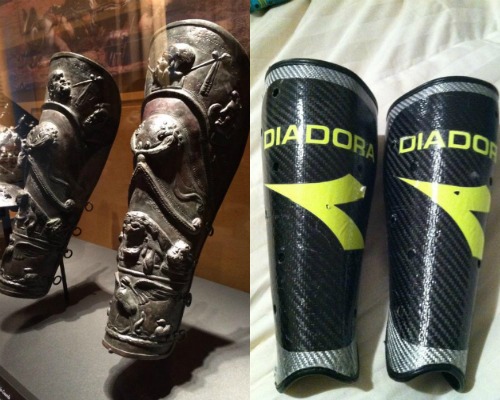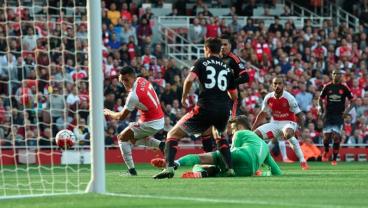The conversation about technology in soccer reached a fever pitch following FIFA’s use of Video Assistant Referees at the Club World Cup. Video replay technology has long been an area of fierce debate, but it’s finally beginning to make headway after the unmitigated success of goal-line technology.
Of course, technology is always re-shaping the game in ways big and small: from the cleats we lace, to the jerseys we wear, to the balls we kick. These advancements are typically rolled out by major manufacturers alongside massive ad campaigns, with celebrity endorsements and much fanfare. However, there is a whole realm of innovation bubbling beneath the surface of the beautiful game, pursued by companies that aren't household names today – but could be soon. The improvements these companies are pursuing could, in time, prove to be absolute game changers.
From a gear company revolutionizing the one piece of soccer equipment left untouched by progress over the past several decades, to a sports science company that has developed a science-fiction-esque way to measure performance and prevent injuries in athletes, we take a look here at two under-hyped innovators in the sport.
G-Form: Bringing Space-Age Materials To Soccer
From the time shin guards were first introduced in the late 1800s as a pair of modified cricket pads to the time they became a FIFA-mandated piece of equipment, the padding has undergone very little change.

We haven't come very far: heavy, cumbersome and outdated. Photos: @DCiabattone | @tazkitty | Twitter
Enter G-Form: an athlete-founded company with a mission to use advanced polymer technology to revolutionize protective equipment – including the one piece of gear that hasn't changed with the times.
As Nick Surface, G-Form's Global Marketing Manager, puts it, "People hate shin guards, but they haven't evolved. Boots, jerseys and socks have all adapted to become lighter, more comfortable and durable, so why not shin guards?"
It seems pretty obvious, but back in 2010 when G-Form launched, no manufacturer had stepped up to take on the challenge.
Don't stop flying into challenges. Don't stop to adjust your guards. Be the force on the field! Pro-S shin guards. Made for dominating. pic.twitter.com/8iFpNOyxnO
— G-Form Soccer (@gformsoccer) January 20, 2017
Since 2010, G-Form has continued to refine its line of shin guards to be extremely lightweight and comfortable, with padding technology that hardens on impact to absorb the nastiest of challenges.
Why should you trust that it works? Well, the same "Reactive Protection Technology" protecting your shins is capable of protecting an iPad dropped from space...without a parachute.
Seems like a pretty safe bet.
The sleeve-style fit also eliminates the possibility of shifting or falling equipment. No more deteriorating velcro, and no more time wasted applying massive amounts of tape to keep shin guards in place.
What’s more, they’re moisture-wicking and washable, a favor that you owe to anyone that has to be within radius of your soccer bag.
Endorsed by Pele and used by the likes of Robbie Keane and Bill Hamid, G-Form’s shin guards are a revolution that’s long been overdue.
Gear up in our goalkeeper gear and become unstoppable! Beast mode saves courtesy of @BillHamid28 of @dcunited: https://t.co/KoFQpVD89B pic.twitter.com/JjVsfYf3Mt
— G-Form (@gform) January 13, 2017
MuscleSound: Using Science To Optimize Performance
Another organization revolutionizing the game with regards to performance is the Denver-based sports science company MuscleSound. MuscleSound allows athletes to instantly scan their major muscle groups, giving them the immediate feedback necessary to reach higher intensity levels, recover and prevent muscle breakdown. If it sounds like the future, that's because it is.
MuscleSound uses a new ultrasound technology that allows players to measure their glycogen levels in real-time. In the past, the only way you could have done this would have been a surgical biopsy, which doesn't sound like a lot of fun the day before a big match. With MuscleSound, these levels can be measured before training, before matches, before bed. In other words, before anything you want.
#MuscleSound provides immediate & actionable info to improve overall #health. Learn more: https://t.co/ArFuJprovZ #glycogen #bodycomposition
— MuscleSound (@musclesound) December 19, 2016
Why does this matter? Well, let's get overly-scientific for a second. The body stores carbohydrates for energy as glycogen. Accordingly, glycogen is the determining factor in energy levels and athletic performance. By using MuscleSound’s ultrasound technology to receive a "Muscle Energy Status" score, which correlates directly to glycogen levels, it’s easy to determine if a player is on the verge of injury due to fatigue or if they’re in need of a harder training regimen.

Uh oh. Looks like it's going to be a rough week for the Springfield Wildcats according to their glycogen heat map (Photo: MuscleSound)
The bad news? Slackers will immediately be discovered. The good news? The prevention of things like soft-tissue injuries.
MuscleSound’s Director of Performance, John Ireland (who happens to have won an MLS championship as fitness coach for the Colorado Rapids and also serves as a consultant for the Dallas Cowboys) outlines the product's benefits as follows:
“It allows you to focus on each individual player within a very small window of time. From training sessions to matches, MuscleSound can give you an exact look into a player’s readiness. How have they been training? How have they been recovering? Do they need to be rested or have their minutes limited?”
For example, a case study was made tracking a Major League Soccer player during a busy portion of the season — the team had two regular season matches and a US Open Cup game in the space of seven days.
The data showed that the player had entered "the red zone" prior to the final game of that stretch, and he was subsequently substituted at half time with the coach admitting that he looked as though he was “running on fumes." His glycogen depletion showed the need to monitor his workload while emphasizing nutrition, regeneration and recovery over a difficult portion of the season.
For Ireland, this example is a perfect mirror for what goes on in England over the course of December and January, when games come thick and fast for clubs.
“It’s brutal, it’s one match after another with little to no recovery time. You have to be careful with what you’re doing in between matches and with how each individual is recovering according to their own needs. For fans, it’s great. For managers and trainers, it’s a nightmare.”
When the glycogen levels in your body begin to deteriorate, that’s when the muscle begins to eat itself and break down, resulting in the muscle injuries that plague athletes.
While MuscleSound is being used in MLS and many other professional sports, it’s not currently working with clubs in Europe. “We’d love to one day be involved with an EPL club, that’s the goal,” said Ireland. “It’s a much more difficult bridge to cross but the benefits of MuscleSound, from energy levels to recovery to injury prevention, all measurable within a very short window of time, make us a perfect fit for that kind of environment.”
While American sports have historically been quicker to embrace technology than soccer (ahem, instant replay), Ireland actually believes it’s the opposite with regards to sports science and medicine.
“What places like the AC Milan Sports Center and managers like Arsene Wenger have done for football was way ahead of anything that was going on over here. It was revolutionary and that sort of focus has really grown in the United States recently, but football, on the whole, has been pioneering this area for some time.”
Looking Ahead To The Future Of The Sport
G-Form’s track record in sports like biking, skateboarding and snowboarding suggests it’s only a matter of time before there's a "new normal" when it comes to protective equipment in soccer. And, with a growing library of data supporting MuscleSound's striking benefits to both professional athletes and clubs, it's no wonder they’re now working to provide their technology to the benefit of municipal and government agencies, such as firefighters, police officers and members of the military.
While FIFA toils and belabors in their own bureaucratic depravity, it’s encouraging to hear about companies that are making cutting-edge advancements with player safety and performance in mind.





